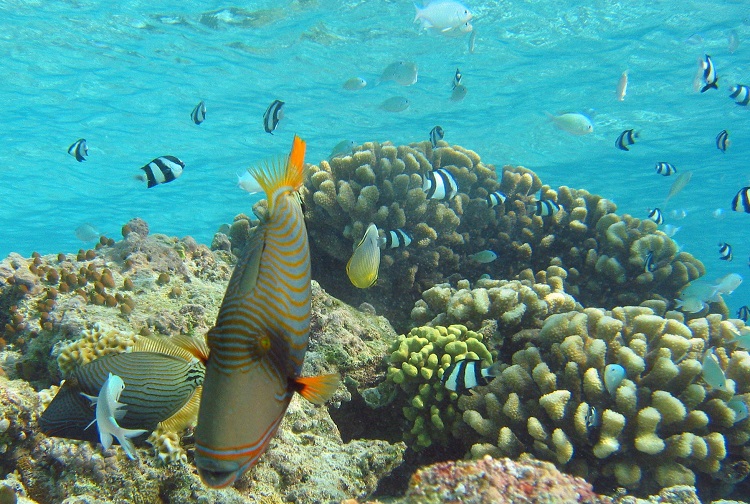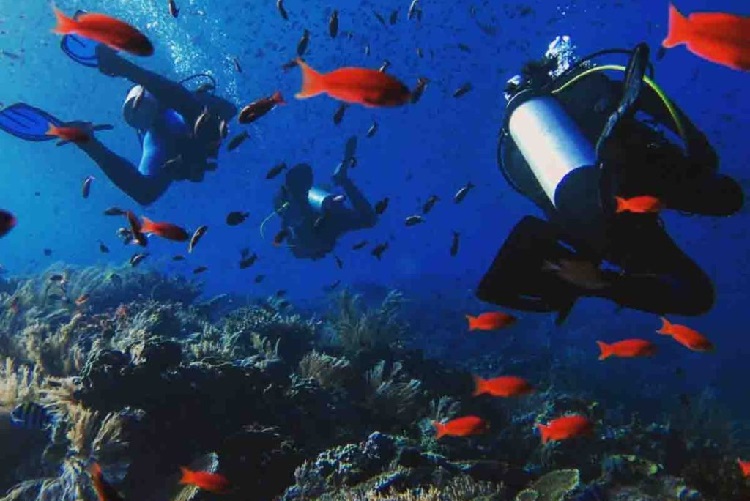Overview
The world’s oceans comprise a wide variety of aquatic habitats that range from coral reefs and oyster beds to salt marshes and mangroves.
These serve a vital role in maintaining the ever-dwindling population of different species. There are two main types of aquatic habitats: marine habitats and freshwater habitats.
In this article, we will explore both kinds of habitats in great detail and discuss how fish use aquatic habitats, what parts of the habitat are used to eat, shelter, or breed, how important aquatic habitats are, why are they under threat, and what we can do to save them.
What Is an Aquatic Habitat?

An aquatic habitat can be defined in more than one way.
In the simplest terms, the term aquatic habitat is used to define the water area that inhabits the fish species and other aquatic organisms, along with the adjoining land region that includes the vegetation. The land area serves its purpose to provide food, shelter, shade, and security to all aquatic organisms.
Another way to define an aquatic habitat is all the chemical, physical, and biological components of the water atmosphere, which combine to form this habitat. These include water debris, temperature, aquatic plants, water level, water flow, and other similar characteristics of the water environment.
All water bodies, such as reservoirs, clear lakes, water streams, rivers, ponds, estuaries, wetlands, and sloughs are considered aquatic habitats.
Types of Aquatic Habitats We Have
Different habitats all around the world that are made up of water combine to form the aquatic biosphere.
There are two main types of aquatic habitats that are classified based on the level of saltiness or salinity. These include freshwater habitats and marine habitats.
Freshwater Ecosystems

As the name suggests, freshwater habitats have a lower level of salinity and stand at less than one percent of saltiness. Examples of fresh water include lakes, swamps, streams, rivers, ponds, lagoons, bogs, and wetlands.
Marine Ecosystems
On the other hand, these habitats have a higher level of salinity. All water habitats that have more than one percent saltiness fall under the category of marine habitation. Examples of this kind of habitat include seas, oceans, and coral reefs.

However, it is important to note here that a few water bodies cannot be classified entirely as marine or freshwater habitats.
Some aquatic habitats are formed by an even blend or combination of freshwater and saltwater habitats. Salt marshes, mangroves, and mud flats are examples of such habitats.
How Fish Use Aquatic Habitats
These habitats play an extremely vital role in maintaining the unwavering fish population all around the water ecosystems. There are multiple ways in which these habitats are used by different species to survive. Let us take a look at a few of the reasons why this habitat is important for the fish.

First and foremost, these habitats are used as a safe spot as well as a hiding spot by the fish.
For instance, in the case of the parrotfish that lives in the South Pacific Ocean and Caribbean Islands, the coral reef habitat is used whenever the fish needs to rest. Some of these fish use the mucus cocoon as a comfortable sleeping spot and wrap them around their bodies.
As the fish rests or sleeps, the coral reefs or mucus cocoon safeguard the fish against predators. This is also true in the case of young fish that use estuaries as their hiding spot until they have grown into capable and strong fish.
These habitats also serve as a means of providing food source to native species. Whales are considered to be the biggest fish in aquatic habitations. They travel to the Gulf of Mexico in search of fish that they can prey on.
On the other hand, smaller fish such as plankton, yield into the water column and travel from one part of the marine habitat to another. As these tiny fish move around, they are preyed on by the whales.
Lastly, coral reefs also protect the eggs of the female lingcod. In order for this to happen, the male lingcod lives on the hard coral reefs and protects the eggs from the attacks of snails, starfish, crabs, sea snakes, and dogfish.
In this way, the marine habitat serves an important role to the aquatic species.
Places To Shelter
The places to shelter fish are required by native fish not to just hide from their predators but also to safeguard themselves from intense environments or conditions. These include extreme tidal flows or extra bright sunlight.

The places used to hide are found in freshwater lakes, estuaries, and water’s edge. There are places behind rocks in freshwater, as well as deep ocean, snags, small parts of vegetation, and undercut or vertical cut banks, where small fish can seek shelter.
There are also mangrove forests and seagrasses in estuaries where juvenile fish cannot be found by their predators.
A good example of the places used for shelter is found in the cases of trout cod and Murray cod. They use branches and logs that are completely submerged.
Places To Breed
It goes without saying that all aquatic animals are very specific about the kind of habitat or environment in which they choose to lay their eggs in. Their decision is influenced by a number of factors including the water temperature, conditions and duration of water flow, and the regulation of rivers.

Different fish prefer different types of habitations in which to reproduce. Inland or local fish use snags or the troughs of logs to lay their eggs. Aquatic vegetation or undercut or vertical banks are the preference of a few other kinds of fish species.
There are also those fish that opt for creating a nest of gravel beds and laying their eggs in that nest. These fish include freshwater catfish and such kinds of fish choose to return to their originally created nest every year.
It is important to keep these habitats intact in order for the fish to be able to reproduce and find a suitable place in which they can place their eggs.
Places To Eat
The most common items that are included in the diet of aquatic species include seagrasses and other plants, seaweed or macroalgae, microscopic or tiny animals and plants called plankton, and other fish.

Benthic invertebrates are also included in this list of dietary items. These consist of dragonflies, mosquitoes, water beetles, shrimp, larvae, sea urchins, boatmen, and mayflies.
The places in which fish can find these items to eat include suspended animal and plant matter, coral reefs, and open ocean habitats. Whales, sharks, sardines, and herrings, feed on animal and plant matter, such as phytoplanktons and zooplanktons. Parrotfish and pacu need the coral reefs to survive.

The conditions of the aquatic habitat directly affect the food sources and the ability of animal species to survive. Too many changes in the habitat may mean that the aquatic organisms can no longer survive.
Aquatic Habitats Are Vital to Our Ecosystem
Water is the largest habitat that has served its purpose over centuries in terms of the environmental value that it provides. They have provided a healthy and fulfilling habitat for the procreation of wildlife as well as the recreation of the human population.

In addition to the above, they play their role in the recycling of water nutrients, mitigation of water catastrophes such as floods, and purification of toxic chemicals in the water. It is the existence of a well-functioning aquatic habitat that not only maintains the flow of water streams but also amplifies it.
These habitats also play a vital role in recharging or refilling groundwater. This protects our coastal regions and stops the water body contaminants to migrate upstream.
Biotic Characteristics (Living Components)
An aquatic ecosystem is recognized or distinguished by its abiotic (nonliving) characteristics and biotic (living) characteristics. The biotic characteristics that make up the aquatic habitat include plant and animal species as well as microbes.

The biotic characteristics can be classified into three main groups: decomposers, producers, and consumers which include omnivores, herbivores, and carnivores. A few examples of biotic factors include sharks, turtles, algae, and anaerobic bacteria.
The Importance of Aquatic Habitat
The aquatic habitat holds great importance. It plays a huge role in maintaining the health of the environment in which we live and breathe today.

The human population around the world is largely dependent on the resources that are obtained from the aquatic habitat for meeting their food and health needs.
These resources also serve as a means for recreation and use for commercial services such as tourism and fishing. Many species themselves also depend on the habitat for meeting their food, shelter, and breeding needs.
Aquatic Habitats Are Under Threat
There are a number of factors that have threatened these habitats. The most important of these are the pollutants that enter the water bodies from groundwater, upstream rivers, precipitation, or simply from the surrounding land areas. These include chemicals, oils, or sewage water that directly threaten the lives of aquatic species.

Low water levels are also a threat to aquatic environments. These cause increased water temperatures, highly concentrated pollutants, decreased oxygen levels, long periods of droughts, and hindered flows of moving fish habitats.
Acid precipitation, disturbance of bank vegetation, disease outbreaks, waterway impediments, presence of intrusive species, human activities, and degradation of the fish habitat, are other reasons why the aquatic ecosystems are under threat.
In conclusion, the climate driven changes in the aquatic habitat that are brought about by changes in the natural or artificial environments are causing a direct threat to the habitat.
What You Can Do To Help

In light of the above threats, it is important to take into consideration what can be done to not just safeguard the aquatic habitat, but also conserve the fish’s life that it inhabits.
This requires the need to implement conservation strategies so that the aquatic resources are not depleted and can be used for generations to come.
Here are a few things that can be done to help conserve and protect the aquatic habitat including both marine and freshwater ecosystems.
- Restoration of habitats that have experienced degradation
- Restoration of species that have declined
- Specify aquatic bio reserves where fishing is restricted or banned in order to protect the aquatic biodiversity
- Plant trees to prevent erosion of soil and siltation of water bodies
- Prevent the discharge of pollutants into the aquatic habitat by not allowing chemical plants, industries, and thermal power plants to set up near water resources
- Issue government programs to protect aquatic biodiversity
- Pass regulations on the discharge of wastewater into the aquatic ecosystems
- The most important measure of all is to increase awareness about the need to protect these habitats.
Conclusion
All water bodies such as reservoirs, lakes, water streams, rivers, ponds, estuaries, wetlands, and sloughs, are considered aquatic habitations. There are two main types of habitats that are classified based on the level of saltiness or salinity. These include both habitats of freshwater and marine.
Aquatic habitation plays an extremely vital role in maintaining the unwavering fish population all around the water ecosystems.
They provide places of shelter that are required by native fish to not just hide from their predators but also safeguard themselves from intense environments or conditions. They also provide breeding grounds for the fish and supply the dietary needs of animal species.
The aquatic habitat holds great importance. It plays a huge role in maintaining the health of the environment in which we live and breathe today. There are a number of factors that have threatened these habitats.
Restoration of habitats that have experienced degradation and issuance of government programs to protect aquatic biodiversity are a few measures that can be taken to conserve and protect water habitations.


